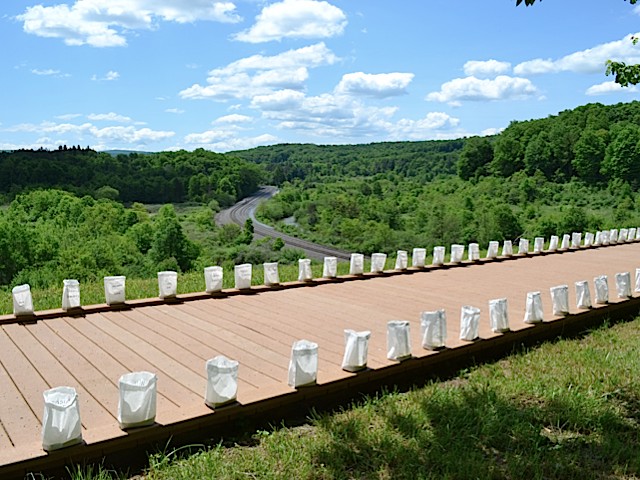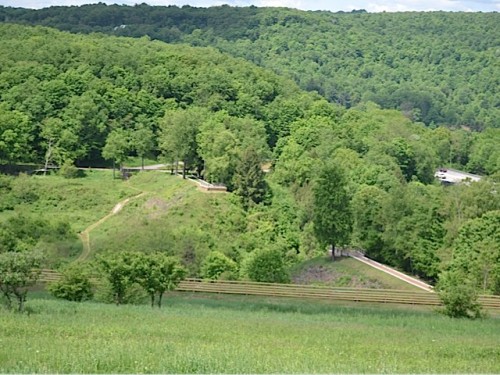
Luminary bags, each one bearing the name of a flood victim, line a walkway on top of what remains of the South Fork Dam. May 31 marked the 125th anniversary of the Johnstown Flood, which took more than 2,200 lives.
My affinity for Johnstown, Pa., dates to March 4, 1975, the night I saw my first professional hockey game.
It was in Lewiston, Maine, and my hometown Maine Nordiques played host to the Johnstown Jets, a rough-and-tumble team that would inspire the iconic 1977 movie “Slap Shot.” Since moving to Pennsylvania in 1991, I have made several pilgrimages to Cambria County, to see hockey games, to ride the Inclined Plane, and to visit the Johnstown Flood Museum.
The 1889 Johnstown Flood claimed more than 2,200 lives — the largest single-day loss of civilian life in American history until 9/11 — and summons many emotions. Sadness for the men, women and children who were its innocent victims. Anger for the human error and neglect that precipitated the breach of South Fork Dam. Awe for the resolve of a community that rebuilt and continues to fight for its economic future against long odds.
For all that I had learned through the years about the Johnstown Flood — the Flood Museum and David McCullough’s book are two terrific places to start — I had never visited the source of the flood until Saturday.
The dam burst on the afternoon of May 31, 1889, loosing 20 million tons of water from South Fork Lake on a 14-mile course of death and destruction toward downtown Johnstown. The National Park Service, which operates the former lake as the Johnstown Flood National Memorial, commemorated the 125th anniversary with a day of activities that included a wreath laying and the reading of each victim’s name.
Arriving mid-morning, I got to see park service representatives placing luminary bags along walls and railings in advance of lighting votive candles at dusk. It was a powerful image under bright sunlight, my eyes watering as I read individual names of victims on each bag. I can only imagine what a somber, emotional yet beautiful scene it must have been in darkness.
Viewed from the National Park Service visitor center, this is what remains of the South Fork Dam. Completed in 1853, the dam created South Fork Lake, which was owned by the South Fork Fishing and Hunting Club at the time of the flood. Wealthy Pittsburghers, including industrialists Henry Clay Frick and Andrew Carnegie, formed the fishing and hunting club in 1879 as a summer retreat.
Visitors can walk on top of what remains of the earthen dam, which when completed in 1853 measured 931 feet end to end. An informational sign notes that the dam gave way under the force of rising floodwaters, “creating the gaping hole in front of you.” There is another public outlook on the other side of the dam.
The Unger House is named for Elias J. Unger, who was manager of the South Fork Fishing and Hunting Club. Today, the house contains National Park Service offices and is not open to the public. If you look in the space framed by the porch roof and posts on the right, you can see the South Fork Fishing and Hunting Club’s clubhouse in the distance. South Fork Lake would have separated the two buildings, whereas today you see trees.
The South Fork Fishing and Hunting Club used this building as its clubhouse. The National Park Service is in the process of restoring the exterior to its original color scheme: light gray with dark red and black accents.
A notice placed on the porch relative to the 125th anniversary activities indicated that the clubhouse, closed on Saturday, “was a site of leisure and recreation used by members of the South Fork Fishing and Hunting Club.
“And the failure of the South Fork Fishing and Hunting Club to properly maintain the dam is a main cause of the Johnstown Flood. For these reasons, the 1889 Clubhouse is not a site of commemoration.”






